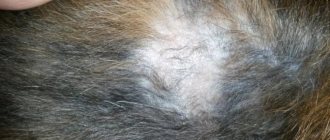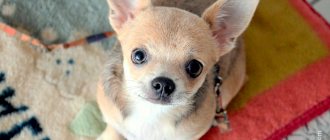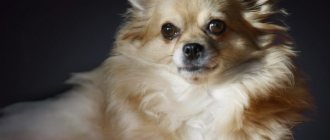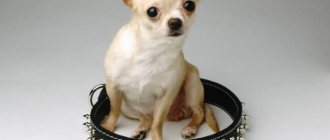All dog owners are faced with the phenomenon of hair loss in their pets. Like any other dogs, Chihuahuas shed – this is a normal natural process. Of course, during this period more careful care is needed for the baby’s fur.
If your pet seems to be losing too much fur, it could be the result of a medical condition. Let's talk about how to properly care for a Chihuahua's hair during the molting period, how to recognize the symptoms of possible problems and deal with them.
Seasonal molting and its function
Shedding is a natural physiological process when a dog gets rid of damaged and excess guard hair and undercoat, making room for the growth of new hair. Both long-haired and smooth-haired Chihuahuas shed. And almost to the same extent, so the opinion that smooth-haired Chihuahuas have less hair is wrong.
The Chihuahua's fur consists of guard hairs and down hairs (undercoat). The RKF Chihuahua breed standards allow dogs with a complete absence of undercoat. The absence of fluff occurs in both long-haired and smooth-haired individuals. According to the information received, the coat of Chihuahua dogs is conditionally divided into 2 types:
- single-haired;
- double-coated.
In dogs, fur performs a protective function of the body from climatic influences. It allows you to regulate body temperature within normal values (37.5-39°C). In humans, sweat glands act as a thermostat. Dogs have fur and other means.
For example, when a dog is hot, it quickens its breathing, presses against cool surfaces, and limits physical activity until the body cools down. To keep warm, the Chihuahua hides under a blanket, cuddles up to the radiator, or basks in the open sunlight, while its metabolism slows down.
Shortly before the onset of cold weather, fine guard and down hairs begin to fall out. It is replaced by a thick and warm “fur coat” that prevents heat from escaping, just as clothing insulates human bodies. In the warm season, on the contrary, the hairline becomes thinner and thinner, which slows down the process of absorbing heat from the environment. Thus, the season when Chihuahuas shed heavily is considered to be autumn and spring. Molting lasts 2-3 weeks.
In dogs, like in humans, hair growth is cyclical and consists of 3 phases:
- Anagen (growth): nutrients enter the hair bulb (follicle) through the blood vessels of the dermal papilla, thereby stimulating hair growth.
- Catagen (death): the dermal papilla atrophies, nutrients stop flowing to the root, as a result of which hair growth stops.
- Telogen (loss): the connection between the follicle and the papilla is broken, the hair is pushed to the surface of the epidermis and falls out naturally.
A new hair follicle is formed around the dermal papilla, and the cycle repeats.
There is such a thing as puppy (juvenile) shedding. Chihuahua puppies are born with fluffy and soft fur. The thermoregulation systems of puppies are turned off, so this “fur coat” protects the body from temperature changes. The complete change from puppy coat to adult coarse coat is completed by 5-6 months of life, when the change of milk teeth in a Chihuahua begins. All stages of fur renewal in a puppy are visible to the naked eye.
Shedding in a dog
To prevent lost dog hair from causing you inconvenience in the form of hair accumulation on your furniture and clothes, you need to take care of your pet.
Short-haired Chihuahuas are usually brushed two to three times a week with a medium-hard brush. Long-haired Chihuahuas should be combed every other day with a wide-toothed comb with blunt ends. They bathe the dog three times a year.
Twice a year, the pet begins to change its coat. This natural process is called molting. During these periods, you need to comb the Chihuahua's coat daily with a special slicker brush to remove dead hair. Otherwise, the growth of new fur becomes difficult. This causes severe anxiety in the pet and he begins to itch constantly.
Dogs with smooth and short hair shed almost imperceptibly, while for long-haired Chihuahuas this is a real event.
Shedding can be divided into several types.
Age-related molting
This type of shedding occurs in Chihuahua puppies. It is associated with the growing up of the baby. Each puppy is born with a soft, short coat that has very fine hairs.
As the dog gets older, the coat changes. Gradually, the first hairs fall out, and new hair grows in their place. Long-haired Chihuahuas acquire long hair, while short-haired Chihuahuas become the owners of smooth hair that fits tightly to the body.
Seasonal molt
This type of shedding is periodic. Seasonal molting occurs in spring and autumn. By winter, Chihuahuas, especially those with long coats, have thicker fur, and by summer it becomes thinner and shorter.
This shedding begins to occur after the dog changes teeth, that is, at three to four months.
Constant shedding
If a dog constantly lives in an apartment and rarely goes out for walks, then its coat changes gradually throughout the year. This is due to the fact that temperature changes at different times of the year do not affect the dog’s coat in any way.
Shedding after pregnancy
This type of shedding occurs in lactating Chihuahua bitches after cessation of lactation.
How do dogs know when it's time to shed?
There is an opinion that the process of changing fur in Chihuahuas is affected by temperature changes in the environment. In fact, the length of daylight hours influences the initiation of the physiological process.
By focusing on the time difference between daylight and darkness, the Chihuahua understands when it is time to shed. These changes regulate the level of melatonin produced by the dog's pineal gland. Melatonin is also called the “hormone of darkness”, because. produced by the body exclusively in the dark.
In other words, the level of melatonin after the spring equinox begins to systematically decrease, because the daily amount of daylight increases. The Chihuahua starts molting, the dog gets rid of excess hair so as not to get heatstroke in a winter “fur coat”.
The autumnal equinox works in reverse. Melatonin levels begin to rise, signaling the body to grow additional fur necessary to retain heat during the cold season. The density of the undercoat and guard hairs increases.
The situation with domestic dogs has destabilized. Artificial light sources negatively affect the animal’s biorhythm. The biological clock is malfunctioning. As a result, there is a violation of the molting schedule. It may begin with a delay or proceed with anomalies. For example, the hair will fall out in whole clumps, forming bald patches.
Causes of excessive hair loss
Seasonal shedding in Chihuahuas proceeds smoothly, so, as a rule, there is no reason for concern. But heavy hair loss, forming bald spots, indicates pathological disorders in the dog’s body. Especially if the animal’s behavior changes dramatically. Possible reasons include:
- poor quality and unbalanced dog diet;
- stress, including that caused by pregnancy, moving to a new home;
- vitamin deficiency due to a lack of vitamins “A” and “B” in the body;
- hormonal imbalance, increased levels of estrogen in the blood;
- food or contact allergies to chemical irritants;
- skin fungal or bacterial infection (ringworm, pyoderma);
- worms, fleas, parasitic mites (skin disease - demodicosis);
- dry skin, itching, rash and flaking (dandruff);
- basal cell carcinoma (carcinoma, basal cell carcinoma, epithelioma).
Alopecia requires an immediate visit to your veterinarian to diagnose the cause of hair loss in your Chihuahua. Entrust the work to a specialist, do not self-medicate! Especially if baldness is accompanied by the following behavioral symptoms:
- aggressive or anxious behavior;
- painful reaction to stroking;
- redness and rashes on the skin;
- refusal of food and drinking water;
- apathetic state, lethargy;
- increased body temperature;
- vomiting, diarrhea, heavy breathing.
Professional breeders note that during pregnancy and nursing puppies, the female Chihuahua sheds heavily. The reason is caused by hormonal stress and is not a pathology!
Hair loss is a signal of a pet health problem
Let's look at the possible reasons:
- Hair sometimes comes out due to a poorly balanced diet or poor-quality pet food. In this case, you should try changing the food; it is also not recommended to buy dog food in bulk, because... It is impossible to determine the expiration date of the product. In addition, you should pay attention to the presence of vitamins necessary for your dog’s coat, in this case these are vitamins A and B;
- Also, excessive hair loss may indicate the presence of parasites or protozoa in the gastrointestinal tract. exactly, as well as the presence of flea or lice ticks.
- Chihuahuas can also shed due to liver, heart and kidney diseases;
- Allergic reaction;
- The reasons may also be less dangerous and hidden on the surface, for example: excessive overheating (perhaps you dress your pet too warmly); too frequent water procedures (due to frequent bathing or the use of inappropriate shampoo, skin depletion occurs);
- A nervous state, rare walks, absence of the owner, moving or improper handling of the animal also cause problems with the coat.
Caring for Chihuahua fur during shedding
Daily brushing of a Chihuahua's coat during shedding is one of the most important care requirements. It promotes the mechanical removal of dead hairs that prevent the growth of new ones. In addition, combing prevents the formation of tangles - an ideal environment for the proliferation of pathogens.
You can use specialized metal combs, slickers, and brushes to remove shedding hair from your dog's coat. I suggest purchasing a more effective and versatile tool at the pet store - a furminator. The seller will help you choose a furminator based on the type of coat (long, short) of your pet. Price: from 1500 rubles.
Bathe your Chihuahua regularly - once every 2 weeks with protein shampoo. Bathing cleanses the dog's coat of dirt, excess oil, dandruff and other debris. Remember that the process can cause pain to the animal, so comb the fur carefully, along the hair growth.
If possible, massage warm coconut oil into your dog's skin after the bath. Give your pet a small teaspoon of salmon oil (with food) for oral administration. Salmon oil is rich in fatty acids necessary for the nutrition and maintenance of the health of the dog's external integument. Rub coconut oil exclusively!
Likely consequences
All of the above types of shedding are normal and do not require outside intervention. But if your pet is shedding hair at the wrong time or this process occurs in some unusual way (for example, the dog is itching), you should not exclude possible health problems. The reasons for unscheduled molting may be the following:
- improper diet leading to vitamin deficiency, especially lack of vitamins A and B; low quality feed; diseases related to the kidneys, liver or heart; hormonal disorders; the presence of parasites in the intestines, fleas and ticks on the skin; allergies to certain foods and feeds; use of low-quality shampoos and sprays for hair care; overheating caused by wearing too warm clothes or being in a hot place; too frequent water procedures; stress caused by rough treatment, departure of the owner, etc.
How to get rid of dog hair in the house
A shedding Chihuahua causes its owner a lot of inconvenience. Falling hairs stick to clothes, upholstered furniture, rugs and paths. It’s also not a good idea to get dog hair in your food. It is impossible to completely get rid of lost hair in an apartment, but the following recommendations will help reduce their accumulation to a minimum:
- make it a habit to brush your Chihuahua not only during the molting period, but also regularly (2-3 times a week);
- to remove wool from floor coverings and furniture, use a vacuum cleaner with an electric brush, or a specialized rubber glove for combing;
- clean clothes using a sticky roller brush to remove lint and lint;
- do wet and dry cleaning at least 2 times a week;
- The robot vacuum cleaner does a good job cleaning the floor.
It is possible that you did not find the answer to your question in the article. If so, watch the video below.
It is also useful for you to know: How to understand the reason why a Chihuahua puppy is constantly itching? Why do Chihuahua dogs tremble for no apparent reason?
Video “All about the Chihuahua breed”
From this video you will learn everything about the popular dog breed - Chihuahua.
Similar article: Dimensions and appearance of the Chihuahua breed according to the standard
Recommended Posts
How to properly keep and care for a Chihuahua
Dimensions and appearance of the Chihuahua breed according to the standard
How to choose a healthy Chihuahua puppy
The most popular and rare Chihuahua colors
How and when to vaccinate Chihuahua puppies











